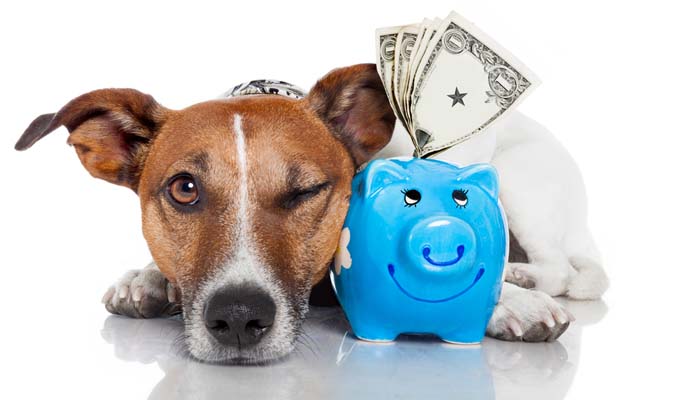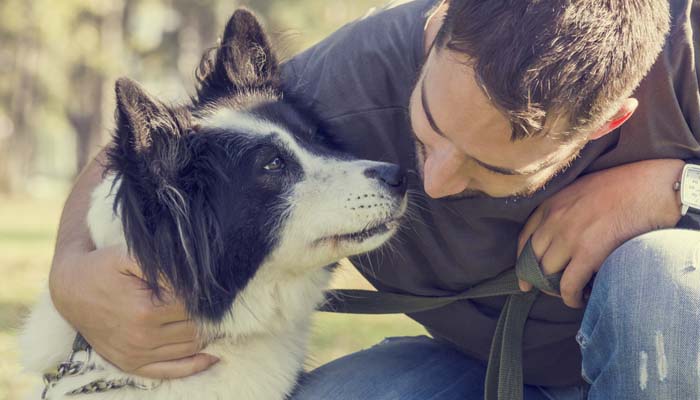
Table of Contents
One of the first things that a person who is considering bringing a new dog into their home wants to know is, how much will it cost?
The cost of owning a dog is a very important question. If you can’t afford to feed and care for an animal, no matter what kind it is, you certainly should not own one.
Unfortunately, gauging the actual cost of dog ownership can be tricky. A lot depends on what size, age, and breed a dog is.
A Saint Bernard will obviously consume more dog food than a Teacup Chihuahua will.
An older dog may require more veterinary care than a puppy, but a puppy may come with the expense of obedience class.
Do you want to serve your pet dry kibble or top shelf dinners? Will your pooch have a custom made dog bed or sleep at the foot of yours?
There are a number of calculators and tables found online which are aimed at helping potential pet owners budget for their new pooch.
Cost of Owning a Dog: What Every Potential Pet Parent Should Know
Sadly, it’s not always easy to tell how up-to-date they are or what area of the country items were priced for. The price of dog food might be lower in the middle of Wisconsin than it is in New York City.
RELATED: 14 Tips on How to Live on a Budget with Dogs
While it doesn’t hurt to get a rough idea of what items and services might cost during your initial search online, if you want to customize your dog budget, follow the suggestions outlined below.
Purchasing a dog
Your initial expense is going to be, of course, that of acquiring the dog itself. This can range anywhere from ‘free’ to thousands of dollars. The best place to connect with people giving away animals at no charge is your local classified listing, whether that’s online or in print.
Local listings
You may be able to find a family who’s dog recently had puppies or a young couple whose new landlord doesn’t allow pets. If this is the case, try to get a hold of any existing vet records as they may come in handy later on.
Animal Shelters
Another low-cost option is your neighborhood shelter – either run by a municipality or a nonprofit organization. Shelters often have a broad selection of dogs that varies day by day, and if they don’t have any dogs that are a good fit, many will be happy to give you a call if the type of dog you’re looking for comes in.
If the shelter is run by a nonprofit, you might also be able to deduct the adoption fee from your taxes at the end of the year. The downside of shopping shelters is that it can be difficult to discover much about the dog’s history, as many shelter pets are abandoned without any background information having been provided.
Pet Stores
Pet stores are an option as well and you can likely pick up your new dog and all of his supplies in one trip. They can offer incentives that come with your pet purchase as well, such as training class discounts or free microchipping.
RELATED: Where to Buy a Dog: Responsible Adoption
Be cautious when buying animals from pet stores though, as several commercial pet stores have been accused of sourcing their pets from “puppy mills,” where dogs are raised under conditions that are often very terrible. Once you’ve narrowed your choice down to a specific store, do some quick research online or speak with the store’s management to find out where their dogs come from.
Breeders and breed-specific rescue organizations
 If a certain breed is what you’re after, two popular options are breeders and breed-specific rescue organizations.
If a certain breed is what you’re after, two popular options are breeders and breed-specific rescue organizations.
While breeders can be very expensive, sometimes charging thousands of dollars for their dogs, they usually keep good record of lineage and pay close attention to developing pets with desired temperaments.
Before making a commitment, make sure your breeder is licensed and registered in compliance with your local state and county laws. Also, take a look at the Humane Society’s “How to find a responsible dog breeder” checklist.
Breed-specific rescue groups specialize in one type of dog, they can be valuable sources of information about any qualities or specific medical needs that the breed may have. As they don’t breed the dogs themselves, they are free from the restrictions placed on breeders, but do still need to adhere to shelter regulations.
Feeding your new pet
After you’ve focused in on where to find your furry friend, you’ll need to figure out how much it will cost to feed him. The cost of owning a dog is greatly affected by the diet that you choose to feed.
The ASPCA’s website suggests that the average annual expense of dog food is anywhere from $55 for small dogs to $235 for large dogs.
If you’d like a custom estimate for pet food in your area and for your specific dog, it will take just a little bit of research and calculation. Here are the steps you’ll need:
- Find out about how much your dog weighs. If there’s one dog you’re planning to adopt or purchase, the person or organization he’s coming from should have this information on hand.
- Contact a couple of local vets and find out how much food they recommend feeding a dog the size of your potential pup. This should give you an idea of how many pounds of dog food per week you’ll need.
- The next time you’re at the pet store or the grocery, take a gander at the dog food prices per pound.
- Multiply the number of pounds per week your dog will need to eat by the price per pound and you’ll arrive at the weekly cost of food for your dog. Multiply that by 52 if you want the yearly cost.
RELATED: Best Dog Food Deals Online
Veterinary Expenses
Veterinary expenses will also make a big difference in the cost of owning a dog. Your dog will need an initial visit (often included in the adoption fee if your dog comes from a shelter), yearly checkups, and periodic shots.
Most dogs will also need one-time vaccinations, and it’s also a good idea to have your dog spayed/neutered and fitted with a microchip. Again, one call to your local vet can provide you with the most accurate fees and charges for these services.
PetCareRx has a rundown of average vet visit costs on their website and their quote for an office visit is $45 to $55 per trip.
Other costs of owning a dog
After your new dog has all of his shots, he will more-often-than-not be required by your city to have a license. It’s usually a small expense around $10 to $20 so there’s no good reason not to check this item off of your list. If your dog gets lost, having a license number tag on his collar will help get him home, and it’s a lot less expensive than having to pay a fine or penalty.
With the most critical costs out of the way, you’ll want to concentrate on a few more necessities, like where your dog will sleep and where he will hang out when you’re not at home. Many dogs like to sleep in a crate and may already be trained for one.
Crate training can be a wonderful tool to keep your dog from destroying the house while you’re at the office, cut down on barking complaints from neighbors, and help him feel more secure in your home. Make sure to get a crate that’s the appropriate size for your new dog. The top rated dog crates on Amazon range from about $50 to $150 on average, depending on size.
RELATED: 10 Tips for Picking Out the Right Extra Large Dog Crate
If you have no previous experience with dogs, or just want a more structured learning environment, you might decide to enroll Fido in an obedience training course. This can add a good chunk of change to the cost of owning a dog. If you don’t know where to find a course, start by looking at your local pet store or community center.
A basic course will run you a just a little over $100 for six weeks of basic training. Having a properly trained dog will benefit the both of you and make your relationship stronger. Since dogs are pack animals, not knowing where they stand in your family’s power hierarchy can be very stressful or confusing for them.
Dogs will typically try to fill the role of “boss” themselves if they don’t understand that it’s your job. Good training can also save you the expense of replacing chewed on belongings. Spending a little now on properly training your pet will make your life much easier in the future.
Of course, there are many items and services available to dog owners aside from the basics listed above. Toys and treats, for example, can add up to a princely sum if you want to pamper your new pet. If you don’t have the time or equipment required to groom your dog, and you get one that needs regular hair care, you’ll have to pay a professional.
Then, there are emergency vet visits, boarding costs, flea treatments, and equipment like food and water bowls and leashes. But, many of these costs crop up infrequently or are unnecessary, and have work-arounds.
If you’re on the hunt for a dog though, you’re most probably a fan of canines. While some expenses can get quite high, it’s hard to put a price on the love and companionship you’ll get in return. After all, there’s a reason human beings domesticated dogs before any other animals. They protect us, give us affection, and help us in ways too numerous to count.















